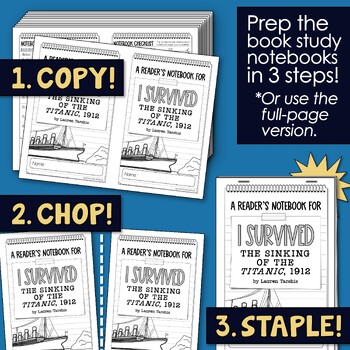I Survived The Sinking of the Titanic, 1912 {Book Study} I Survived #1
- PDF
What educators are saying
Description
This resource is a reader's notebook book study for I Survived The Sinking of the Titanic, 1912, by Lauren Tarshis, Book #1 in the I Survived series.
Students love having their own little notebooks. Teachers love having students think deeply about text. And who doesn’t love the I Survived series?
Combine all of this good stuff with my book study for I Survived The Sinking of the Titanic, 1912. It's easy to prepare and can be used in several ways: independent book study, partner reading assignment, student book club, guided reading group, or even a guided whole class book study! (Note: Each student using this book study should have a copy of the book. Actual book not included.)
Check out the preview for a closer look!
22 reader's notebook printables are included, specifically designed for the book, I Survived The Sinking of the Titanic, 1912. The basic framework of the book study has students read two chapters of the book at a time, then complete two notebook pages covering the pair of chapters just read.
Here is a breakdown of the types of notebook pages included in the resource:
- Notebook Cover Sheet
- Notebook Checklist: a table of contents for the notebook, allowing students to keep to a schedule and track completed pages
- "Before You Begin the Book" Page: a preview page done before students start reading
- "Step In" Pages: these pages step IN to the story, asking questions about the characters and the events happening in the story. (8 "Step In" pages are included, one after every two chapters.)
- "Step Out" Pages: these pages step OUT of the book, asking questions about author choices, literary devices, and story structure. (8 "Step Out" pages are included, one after every two chapters.)
- "Look Ahead" Vocabulary: a section at the end of "Step Out" pages introducing upcoming vocabulary words
- "After You Finish the Book" Page: a post-reading page concerning the whole book
- Book Club Insert (Optional): an agenda to guide book club meetings
- Discussion Questions (Optional): a page with three big questions to discuss after reading the book, then to write an extended response to one
Formats include:
- Half-Page layout
- Full-Page layout
- Answer Key
(Note: In the half-page layout, two copies of each page will print on each sheet of paper. With each set you print/copy, you'll chop the sheets in half and staple along the top edge, creating two fun little notebooks! If you need only one notebook, I've also included a single-student version to help you save paper.)
Check out all my book studies for the I Survived series:
#1 I Survived The Sinking of the Titanic, 1912 {Book Study}
#2 I Survived The Shark Attacks of 1916 {Book Study}
#15 I Survived The American Revolution, 1776 {Book Study}
See ALL my book study reader's notebooks HERE!
Be sure to follow me to receive updates when I post more book studies!
Visit me at The Thinker Builder, and on Instagram, Facebook, & Pinterest!
**For personal and single classroom use only. If using with multiple classrooms, please purchase additional licenses at the discounted rate.**





